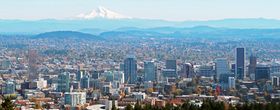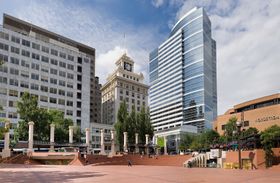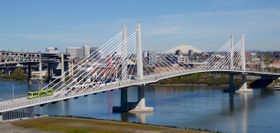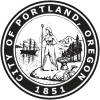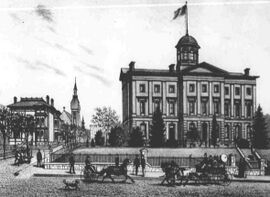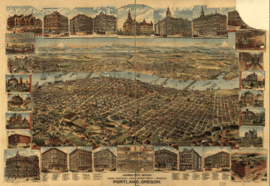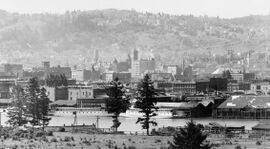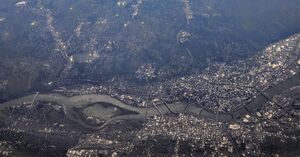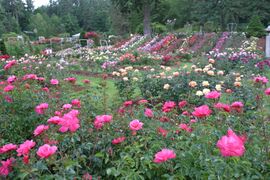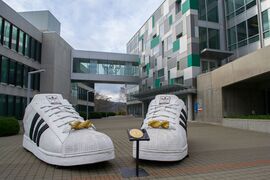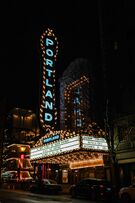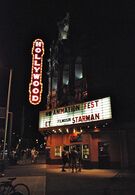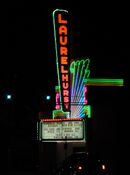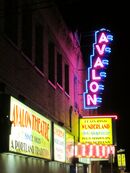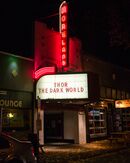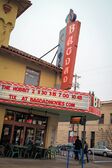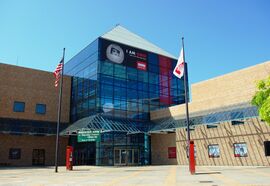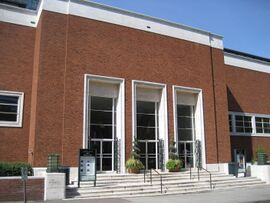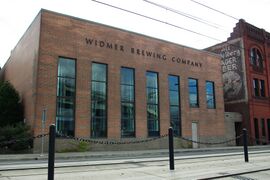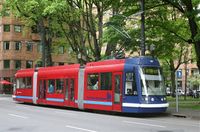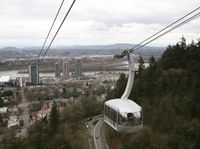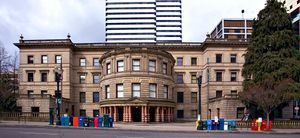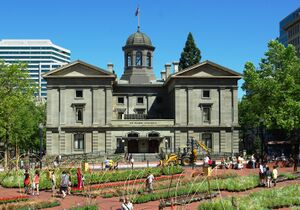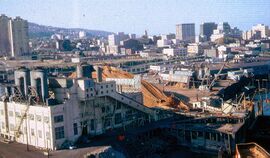بورتلاند، أوريغون
پورتلاند، أوريجون
Portland, Oregon | |||
|---|---|---|---|
من أعلى: المدينة وجبل هود من قلعة پيتكوك، جسر سانت جونز، مركز أوريجون للمؤتمرات، محطة يونيون وبرج يو إس بانكورپ، ميدان محكمة پيونير، تقاطع تيليكوم. | |||
| الكنية: | |||
خريطة تفاعلية لپورتلاند | |||
| الإحداثيات: 45°31′12″N 122°40′55″W / 45.52000°N 122.68194°WCoordinates: 45°31′12″N 122°40′55″W / 45.52000°N 122.68194°W | |||
| البلد | الولايات المتحدة | ||
| الولاية | أوريجون | ||
| المقاطعات | مولتنوما واشنطن كلاكاماس | ||
| المنطقة الحيوية | كاسكاديا | ||
| تأسست | 1845 | ||
| دُمجت | 8 فبراير 1851 | ||
| السمِيْ | بورتلاند، مين[1] | ||
| الحكومة | |||
| • النوع | المفوضية | ||
| • العمدة | تد ويلر[2] (د) | ||
| • Commissioners | |||
| • المدقق | ماري هول كابالرو | ||
| المساحة | |||
| • مدينة | 144٫98 ميل² (375٫50 كم²) | ||
| • البر | 133٫42 ميل² (345٫57 كم²) | ||
| • الماء | 11٫56 ميل² (29٫93 كم²) | ||
| • الحضر | 524٫38 ميل² (1٬358٫1 كم²) | ||
| المنسوب | 50 ft (15٫2 m) | ||
| أعلى منسوب | 1٬188 ft (362 m) | ||
| أوطى منسوب | 0٫62 ft (0٫19 m) | ||
| التعداد | |||
| • مدينة | 652٬503 | ||
| • الترتيب | 72 في أمريكا الشمالية 26 في الولايات المتحدة 1st في أوريغون | ||
| • الكثافة | 4٬888٫10/sq mi (1٬887٫30/km2) | ||
| • Urban | 2٬104٬238 (US: 23) | ||
| • الكثافة الحضرية | 4٬052٫1/sq mi (1٬564٫5/km2) | ||
| • العمرانية | 2٬511٬612 (US: 25) | ||
| صفة المواطن | Portlander | ||
| منطقة التوقيت | UTC−08:00 (PST) | ||
| • الصيف (التوقيت الصيفي) | UTC−07:00 (PDT) | ||
| الرمز البريدي | 97086–97299 | ||
| رمز المنطقة | 503 و971 | ||
| رمز FIPS | 41-59000 | ||
| GNIS feature ID | 1136645[7] | ||
| الموقع الإلكتروني | www.portlandoregon.gov | ||
پورتلاند (إنگليزية: Portland)، هي أكبر مدن ولاية اوريگون الأمريكية. تقع عند التقاء نهر ويلاميت ونهر كولومبيا، في شمال الولاية. عدد سكانها 556000 نسمة، وهي ثالث أكبر مدن منطقة الشمال الأوسط المطلة على المحيط الهادي بعد سياتل (واشنطن) وفانكوفر (كندا). وتقع في مقاطعة ملتنوما، في المنطقة المناخية التي تسمى بالساحل الغربي البحري، التي تعرف بالصيف الدافئ والشتاء الممطر المعتدل، وتسمى بـ "مدينة الورود" لوجود الكثير من حدائق الورود. بورتلاند هي إحدى المدينتين الأمريكيتين اللتين تحتويان على بركان خامد. Situated in the northwestern area of the state at the confluence of the Willamette and Columbia rivers, Portland is the county seat of Multnomah County, the most populous county in Oregon. اعتبارا من 2020[تحديث] Portland had a population of 652,503,[8] making it the 26th-most populated city in the United States, the sixth-most populous on the West Coast, and the second-most populous in the Pacific Northwest, after Seattle.[9] Approximately 2.5 million people live in the Portland metropolitan statistical area, making it the 25th most populous in the United States. About half of Oregon's population resides within the Portland metropolitan area.[أ]
Named after Portland, Maine,[10] the Oregon settlement began to be populated in the 1840s, near the end of the Oregon Trail. Its water access provided convenient transportation of goods, and the timber industry was a major force in the city's early economy. At the turn of the 20th century, the city had a reputation as one of the most dangerous port cities in the world, a hub for organized crime and racketeering. After the city's economy experienced an industrial boom during World War II, its hard-edged reputation began to dissipate. Beginning in the 1960s,[11] Portland became noted for its growing liberal and progressive political values, earning it a reputation as a bastion of counterculture.[12]
The city operates with a commission-based government, guided by a mayor and four commissioners, as well as Metro, the only directly elected metropolitan planning organization in the United States.[13][14] Its climate is marked by warm, dry summers and cool, rainy winters. This climate is ideal for growing roses, and Portland has been called the "City of Roses" for over a century.[15]
. . . . . . . . . . . . . . . . . . . . . . . . . . . . . . . . . . . . . . . . . . . . . . . . . . . . . . . . . . . . . . . . . . . . . . . . . . . . . . . . . . . . . . . . . . . . . . . . . . . . . . . . . . . . . . . . . . . . . . . . . . . . . . . . . . . . . . . . . . . . . . . . . . . . . . . . . . . . . . . . . . . . . . . .
التاريخ
قبل التاريخ
During the prehistoric period, the land that would become Portland was flooded after the collapse of glacial dams from Lake Missoula, in what would later become Montana. These massive floods occurred during the last ice age and filled the Willamette Valley with 300 to 400 feet (91 to 122 m) of water.[16]
Before American settlers began arriving in the 1800s, the land was inhabited for many centuries by two bands of indigenous Chinook people – the Multnomah and the Clackamas.[17] The Chinook people occupying the land were first documented in 1805 by Meriwether Lewis and William Clark.[18] Before its European settlement, the Portland Basin of the lower Columbia River and Willamette River valleys had been one of the most densely populated regions on the Pacific Coast.[18]
التأسيس
Large numbers of pioneer settlers began arriving in the Willamette Valley in the 1840s via the Oregon Trail, with many arriving in nearby Oregon City.[19] A new settlement then emerged ten miles from the mouth of the Willamette River,[20] roughly halfway between Oregon City and Hudson’s Bay Company’s Fort Vancouver. This community was initially referred to as "Stumptown" and "The Clearing" because of the many trees cut down to allow for its growth.[21] In 1843 William Overton saw potential in the new settlement but lacked the funds to file an official land claim. For 25 cents, Overton agreed to share half of the 640-acre (2.6 km2) site with Asa Lovejoy of Boston.[22]
In 1845, Overton sold his remaining half of the claim to Francis W. Pettygrove of Portland, Maine. Both Pettygrove and Lovejoy wished to rename "The Clearing" after their respective hometowns (Lovejoy's being Boston, and Pettygrove's, Portland). This controversy was settled with a coin toss that Pettygrove won in a series of two out of three tosses, thereby providing Portland with its namesake.[1] The coin used for this decision, now known as the Portland Penny, is on display in the headquarters of the Oregon Historical Society. At the time of its incorporation on February 8, 1851, Portland had over 800 inhabitants,[23] a steam sawmill, a log cabin hotel, and a newspaper, the Weekly Oregonian. A major fire swept through downtown in August 1873, destroying twenty blocks on the west side of the Willamette along Yamhill and Morrison Streets, and causing $1.3 million in damage,[24] roughly equivalent to $25.2 million today.[25] By 1879, the population had grown to 17,500 and by 1890 it had grown to 46,385.[26] In 1888, the first steel bridge on the West Coast was opened in Portland,[27] the predecessor of the 1912 namesake Steel Bridge that survives today. In 1889, Henry Pittock's wife, Georgiana, established the Portland Rose Society. The movement to make Portland a "Rose City" started as the city was preparing for the 1905 Lewis and Clark Centennial Exposition.[15]
Portland's access to the Pacific Ocean via the Willamette and Columbia rivers, as well as its easy access to the agricultural Tualatin Valley via the "Great Plank Road" (the route of current-day U.S. Route 26), provided the pioneer city with an advantage over other nearby ports, and it grew very quickly.[28] Portland remained the major port in the Pacific Northwest for much of the 19th century, until the 1890s, when Seattle's deepwater harbor was connected to the rest of the mainland by rail, affording an inland route without the treacherous navigation of the Columbia River. The city had its own Japantown,[29] for one, and the lumber industry also became a prominent economic presence, due to the area's large population of Douglas fir, western hemlock, red cedar, and big leaf maple trees.[18]
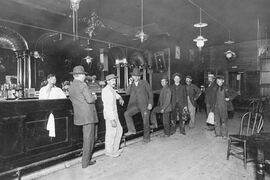
Portland developed a reputation early in its history as a hard-edged and gritty port town.[31] Some historians have described the city's early establishment as being a "scion of New England; an ends-of-the-earth home for the exiled spawn of the eastern established elite."[32] In 1889, The Oregonian called Portland "the most filthy city in the Northern States", due to the unsanitary sewers and gutters,[33] and, at the turn of the 20th century, it was considered one of the most dangerous port cities in the world.[34] The city housed a large number of saloons, bordellos, gambling dens, and boardinghouses which were populated with miners after the California Gold Rush, as well as the multitude of sailors passing through the port.[31] By the early 20th century, the city had lost its reputation as a "sober frontier city" and garnered a reputation for being violent and dangerous.[31][35]
التطور في القرن العشرين
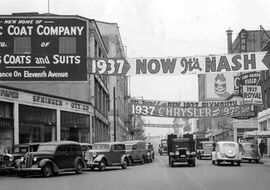
Between 1900 and 1930, the city's population tripled from nearly 100,000 to 301,815.[36] During World War II, it housed an "assembly center" from which up to 3,676 people of Japanese descent were dispatched to internment camps in the heartland. It was the first American city to have residents report thus,[37] and the Pacific International Livestock Exposition operated from May through September 10, 1942, processing people from the city, northern Oregon, and central Washington.[38] General John DeWitt called the city the first "Jap-free city on the West Coast."[37]
At the same time, Portland became a notorious hub for underground criminal activity and organized crime in the 1940s and 1950s.[39] In 1957, Life magazine published an article detailing the city's history of government corruption and crime, specifically its gambling rackets and illegal nightclubs.[39] The article, which focused on crime boss Jim Elkins, became the basis of a fictionalized film titled Portland Exposé (1957). In spite of the city's seedier undercurrent of criminal activity, Portland enjoyed an economic and industrial surge during World War II. Ship builder Henry J. Kaiser had been awarded contracts to build Liberty ships and aircraft carrier escorts, and chose sites in Portland and Vancouver, Washington, for work yards.[40] During this time, Portland's population rose by over 150,000, largely attributed to recruited laborers.[40]
During the 1960s, an influx of hippie subculture began to take root in the city in the wake of San Francisco's burgeoning countercultural scene.[11] The city's Crystal Ballroom became a hub for the city's psychedelic culture, while food cooperatives and listener-funded media and radio stations were established.[41] A large social activist presence evolved during this time as well, specifically concerning Native American rights, environmentalist causes, and gay rights.[41] By the 1970s, Portland had well established itself as a progressive city, and experienced an economic boom for the majority of the decade; however, the slowing of the housing market in 1979 caused demand for the city and state timber industries to drop significantly.[42]
منذ 1990
In the 1990s, the technology industry began to emerge in Portland, specifically with the establishment of companies such as Intel, which brought more than US$10 billion in investments in 1995 alone.[43] After 2000, Portland experienced significant growth, with a population rise of over 90,000 between the years 2000 and 2014.[44] The city's increasing reputation for culture established it as a popular city for young people, and it was second only to Louisville, Kentucky as one of the cities to attract and retain the highest number of college-educated people in the United States.[45] Between 2001 and 2012, Portland's gross domestic product per person grew by fifty percent, more than any other city in the country.[45]
The city acquired a diverse range of nicknames throughout its history, though it is most often called "Rose City" or "The City of Roses"[46] (unofficial nickname since 1888, official since 2003).[47] Another widely used nickname by local residents in everyday speech is "PDX", the airport code for Portland International Airport. Other nicknames include Bridgetown,[48] Stumptown,[49] Rip City,[50] Soccer City,[51][52] P-Town,[47][53] Portlandia, and the more antiquated Little Beirut.[54]
. . . . . . . . . . . . . . . . . . . . . . . . . . . . . . . . . . . . . . . . . . . . . . . . . . . . . . . . . . . . . . . . . . . . . . . . . . . . . . . . . . . . . . . . . . . . . . . . . . . . . . . . . . . . . . . . . . . . . . . . . . . . . . . . . . . . . . . . . . . . . . . . . . . . . . . . . . . . . . . . . . . . . . . .
احتجاجات جورج فلويد 2020
From May 28, 2020 until spring 2021,[55] there were daily protests about the murder of George Floyd by police, and racial injustice. There were instances of looting, vandalism, and police actions causing injuries. One protestor was killed by an opposing one.[56][57][58][59] Local businesses reported losses totaling millions of dollars as the result of vandalism and looting, according to Oregon Public Broadcasting.[60] Some protests caused injury to protesters and police. In July, federal officers were deployed to safeguard federal property; their presence and tactics were criticized by Oregon officials, who demanded they leave, while lawsuits were filed against local and federal law enforcement alleging wrongful actions by them.[61][62][63][64]
On May 25, 2021, a protest to commemorate the one-year anniversary of Floyd's murder caused property damage, and was followed by a number of arrests.[65][66]
الجغرافيا
Geology
Portland lies on top of a dormant volcanic field known as the Boring Lava Field, named after the nearby bedroom community of Boring.[67] The Boring Lava Field has at least 32 cinder cones such as Mount Tabor,[68] and its center lies in southeast Portland. Mount St. Helens, a highly active volcano 50 miles (80 km) northeast of the city in Washington state, is easily visible on clear days and is close enough to have dusted the city with volcanic ash after its eruption on May 18, 1980.[69] The rocks of the Portland area range in age from late Eocene to more recent eras.[70]
Multiple shallow, active fault lines traverse the Portland metropolitan area.[71] Among them are the Portland Hills Fault on the city's west side,[72] and the East Bank Fault on the east side.[73] According to a 2017 survey, several of these faults were characterized as "probably more of a hazard" than the Cascadia subduction zone due to their proximities to population centers, with the potential of producing magnitude 7 earthquakes.[71] Notable earthquakes that have impacted the Portland area in recent history include the 6.8-magnitude Nisqually earthquake in 2001, and a 5.6-magnitude earthquake that struck on March 25, 1993.[74][75]
Per a 2014 report, over 7,000 locations within the Portland area are at high risk for landslides and soil liquefaction in the event of a major earthquake, including much of the city's west side (such as Washington Park) and sections of Clackamas County.[76]
Topography
Portland is 60 miles (97 km) east of the Pacific Ocean at the northern end of Oregon's most populated region, the Willamette Valley. Downtown Portland straddles the banks of the Willamette River, which flows north through the city center and separates the city's east and west neighborhoods. Less than 10 miles (16 km) from downtown, the Willamette River flows into the Columbia River, the fourth-largest river in the United States, which divides Oregon from Washington state. Portland is approximately 100 miles (160 km) upriver from the Pacific Ocean on the Columbia.
Though much of downtown Portland is relatively flat, the foothills of the Tualatin Mountains, more commonly referred to locally as the "West Hills", pierce through the northwest and southwest reaches of the city. Council Crest Park at 1,073 feet (327 m) is often quoted as the highest point in Portland; however, the highest point in Portland is on a section of NW Skyline Blvd just north of Willamette Stone Heritage site.[77] The highest point east of the river is Mt. Tabor, an extinct volcanic cinder cone, which rises to 636 feet (194 m). Nearby Powell Butte and Rocky Butte rise to 614 feet (187 m) and 612 feet (187 m), respectively. To the west of the Tualatin Mountains lies the Oregon Coast Range, and to the east lies the actively volcanic Cascade Range. On clear days, Mt. Hood and Mt. St. Helens dominate the horizon, while Mt. Adams and Mt. Rainier can also be seen in the distance.
According to the United States Census Bureau, the city has an area of 145.09 square miles (375.78 km2), of which 133.43 square miles (345.58 km2) is land and 11.66 square miles (30.20 km2) is water.[78] Although almost all of Portland is within Multnomah County, small portions of the city are within Clackamas and Washington Counties, with populations estimated at 785 and 1,455, respectively.[بحاجة لمصدر]
Climate
Portland has a warm-summer Mediterranean climate (Köppen Csb) falling just short of a hot-summer Mediterranean climate (Köppen Csa) with cool and rainy winters, and warm and dry summers.[79] This climate is characterized by having overcast, wet, and changing weather conditions in fall, winter, and spring, as Portland lies in the direct path of the stormy westerly flow, and warm, dry summers when the North Pacific High reaches its northernmost point in mid-summer.[80] Portland's USDA Plant Hardiness Zone is 8b, with parts of the Downtown area falling into zone 9a.[81]
Winters are cool, cloudy, and rainy. The coldest month is December with an average daily high temperature of 46.9 °F (8.3 °C), although overnight lows usually remain above freezing by a few degrees. Evening temperatures fall to or below freezing 32 nights per year on average, but very rarely below 18 °F (−8 °C). There are only 2.1 days per year where the daytime high temperature fails to rise above freezing; the mean for the coldest high is at the exact freezing point of 32 °F (0 °C).[82] The lowest overnight temperature ever recorded was −3 °F (−19 °C),[81] on February 2, 1950,[82] while the coldest daytime high temperature ever recorded was 14 °F (−10 °C) on December 30, 1968.[82] The average window in which freezing temperatures may occur is between November 15 and March 19, allowing a growing season of 240 days.[82]
Annual snowfall in Portland is 4.3 inches (10.9 cm), which usually falls between December and March.[83] The city of Portland avoids snow more frequently than its suburbs, due in part to its low elevation and the urban heat island effect. Neighborhoods outside of the downtown core, especially in slightly higher elevations near the West Hills and Mount Tabor, can experience a dusting of snow while downtown receives no accumulation at all. The city has experienced a few major snow and ice storms in its past, with extreme totals having reached 44.5 in (113 cm) at the airport in 1949–50 and 60.9 in (155 cm) at downtown in 1892–93.[84][85]
Summers in Portland are warm, dry, and sunny, though the sunny warm weather is short-lived, from mid-June to early September.[86] June, July, August and September account for a combined 4.19 inches (106 mm) of total rainfall – only 11% of the 36.91 in (938 mm) of annual precipitation. The warmest month is August, with an average high temperature of 82.3 °F (27.9 °C). Because of its inland location 70 miles (110 km) from the coast, as well as the protective nature of the Oregon Coast Range to its west, Portland summers are less susceptible to the moderating influence of the nearby Pacific Ocean. Consequently, Portland occasionally experiences heat waves, with temperatures rising above 90 °F (32 °C) for a few days. However, on average, temperatures reach or exceed 80 °F (27 °C) on only 61 days per year, of which 15 days will reach 90 °F (32 °C) and only 1.3 days will reach 100 °F (38 °C). In 2018 more 90-degree days were recorded than ever before.[87]
On June 28, 2021, Portland recorded its all-time record high temperature of 116 °F (47 °C) and its warmest daily low temperature of 75 °F (24 °C) during a major regional heat wave.[88] The record had been broken for three consecutive days with daytime highs of 108 °F (42 °C) on June 26 and 112 °F (44 °C) on June 27; the previous record of 107 °F (42 °C) was set in July 1965 and matched twice in August 1981.[89][90] A temperature of 100 °F (38 °C) has been recorded in all five months from May through September. The warmest night of the year averages 68 °F (20 °C).[82]
Spring and fall can bring variable weather including high-pressure ridging that sends temperatures surging above 80 °F (27 °C) and cold fronts that plunge daytime temperatures into the 40s °F (4–9 °C). However, lengthy stretches of overcast days beginning in mid-fall and continuing into mid-spring are most common. Rain often falls as a light drizzle for several consecutive days at a time, contributing to 155 days on average with measurable (≥0.01 in or 0.25 mm) precipitation annually. Temperatures have reached 90 °F (32 °C) as early as April 30 and as late as October 5, while 80 °F (27 °C) has been reached as early as April 1 and as late as October 21. Thunderstorms are uncommon and tornadoes are very rare, although they do occur.[91][92]
| بيانات مناخ Portland, Oregon (PDX), 1991–2020 normals,[ب] snow days 1981-2010, extremes 1940–present[ت] | |||||||||||||
|---|---|---|---|---|---|---|---|---|---|---|---|---|---|
| الشهر | يناير | فبراير | مارس | أبريل | مايو | يونيو | يوليو | أغسطس | سبتمبر | اكتوبر | نوفمبر | ديسمبر | العام |
| العظمى القياسية °ف (°س) | 66 (18.9) |
71 (21.7) |
80 (26.7) |
90 (32.2) |
100 (37.8) |
116 (46.7) |
107 (41.7) |
107 (41.7) |
105 (40.6) |
92 (33.3) |
73 (22.8) |
65 (18.3) |
116 (46٫7) |
| العظمى المتوسطة °ف (°س) | 47.5 (8.61) |
51.5 (10.83) |
56.8 (13.78) |
62.0 (16.67) |
69.3 (20.72) |
74.3 (23.5) |
81.9 (27.72) |
82.3 (27.94) |
76.7 (24.83) |
64.4 (18) |
53.5 (11.94) |
46.9 (8.28) |
63٫9 (17٫72) |
| المتوسط اليومي °ف (°س) | 41.9 (5.5) |
44.1 (6.72) |
48.3 (9.06) |
52.8 (11.56) |
59.4 (15.22) |
64.2 (17.89) |
70.2 (21.22) |
70.6 (21.44) |
65.4 (18.56) |
55.6 (13.11) |
47.1 (8.39) |
41.6 (5.33) |
55٫1 (12٫833) |
| الصغرى المتوسطة °ف (°س) | 36.2 (2.33) |
36.8 (2.67) |
39.7 (4.28) |
43.7 (6.5) |
49.4 (9.67) |
54.1 (12.28) |
58.5 (14.72) |
58.9 (14.94) |
54.1 (12.28) |
46.7 (8.17) |
40.6 (4.78) |
36.2 (2.33) |
46٫2 (7٫89) |
| الصغرى القياسية °ف (°س) | −2 (-18.9) |
−3 (-19.4) |
19 (-7.2) |
29 (-1.7) |
29 (-1.7) |
39 (3.9) |
43 (6.1) |
44 (6.7) |
34 (1.1) |
26 (-3.3) |
13 (-10.6) |
6 (-14.4) |
−3 (−19٫4) |
| هطول inches (mm) | 5.03 (127.8) |
3.68 (93.5) |
3.97 (100.8) |
2.89 (73.4) |
2.51 (63.8) |
1.63 (41.4) |
0.50 (12.7) |
0.54 (13.7) |
1.52 (38.6) |
3.42 (86.9) |
5.45 (138.4) |
5.77 (146.6) |
36٫91 (937٫5) |
| سقوط الثلج inches (cm) | 1.7 (4.3) |
1.2 (3) |
0.1 (0.3) |
0.0 (0) |
0.0 (0) |
0.0 (0) |
0.0 (0) |
0.0 (0) |
0.0 (0) |
0.0 (0) |
0.0 (0) |
1.3 (3.3) |
4٫3 (10٫9) |
| % Humidity | 80.9 | 78.0 | 74.6 | 71.6 | 68.7 | 65.8 | 62.8 | 64.8 | 69.4 | 77.9 | 81.5 | 82.7 | 73٫2 |
| Avg. precipitation days (≥ 0.01 in) | 18.6 | 15.5 | 17.7 | 17.2 | 13.0 | 9.1 | 3.6 | 3.6 | 6.6 | 13.5 | 18.3 | 19.2 | 155٫8 |
| Avg. snowy days (≥ 0.1 in) | 1.0 | 0.7 | 0.3 | 0.0 | 0.0 | 0.0 | 0.0 | 0.0 | 0.0 | 0.0 | 0.1 | 0.9 | 3٫0 |
| Sunshine hours | 85.6 | 116.4 | 191.1 | 221.1 | 276.1 | 290.2 | 331.9 | 298.1 | 235.7 | 151.7 | 79.3 | 63.7 | 2٬340٫9 |
| Source #1: NOAA (relative humidity, dewpoint and sun 1961–1990)[82][94][95] | |||||||||||||
| Source #2: Weather Atlas [96] (UV index) | |||||||||||||
. . . . . . . . . . . . . . . . . . . . . . . . . . . . . . . . . . . . . . . . . . . . . . . . . . . . . . . . . . . . . . . . . . . . . . . . . . . . . . . . . . . . . . . . . . . . . . . . . . . . . . . . . . . . . . . . . . . . . . . . . . . . . . . . . . . . . . . . . . . . . . . . . . . . . . . . . . . . . . . . . . . . . . . .
Cityscape
Portland's cityscape derives much of its character from the many bridges that span the Willamette River downtown, several of which are historic landmarks, and Portland has been nicknamed "Bridgetown" for many decades as a result.[48] Three of downtown's most heavily used bridges are more than 100 years old and are designated historic landmarks: Hawthorne Bridge (1910), Steel Bridge (1912), and Broadway Bridge (1913). Portland's newest bridge in the downtown area, Tilikum Crossing, opened in 2015 and is the first new bridge to span the Willamette in Portland since the 1973 opening of the double-decker Fremont Bridge.[97]
Other bridges that span the Willamette River in the downtown area include the Burnside Bridge, the Ross Island Bridge (both built 1926), and the double-decker Marquam Bridge (built 1966). Other bridges outside the downtown area include the Sellwood Bridge (built 2016) to the south; and the St. Johns Bridge, a Gothic revival suspension bridge built in 1931, to the north. The Glenn L. Jackson Memorial Bridge and the Interstate Bridge provide access from Portland across the Columbia River into Washington state.
المناخ
| متوسطات الطقس لپورتلاند، اوريگون | |||||||||||||
|---|---|---|---|---|---|---|---|---|---|---|---|---|---|
| شهر | يناير | فبراير | مارس | أبريل | مايو | يونيو | يوليو | أغسطس | سبتمبر | اكتوبر | نوفمبر | ديسمبر | السنة |
| العظمى القياسية °F (°C) | 63 (17) | 71 (22) | 80 (27) | 87 (31) | 100 (38) | 100 (38) | 107 (42) | 107 (42) | 105 (41) | 92 (33) | 73 (23) | 65 (18) | 107 (42) |
| متوسط العظمى °ف (°م) | 45.4 (7) | 51.0 (11) | 56.0 (13) | 60.6 (16) | 67.1 (20) | 74.0 (23) | 79.9 (27) | 80.3 (27) | 74.6 (24) | 64.0 (18) | 52.6 (11) | 45.6 (8) | 62٫6 (17) |
| متوسط الصغرى °ف (°م) | 33.7 (1) | 36.1 (2) | 38.6 (4) | 41.3 (5) | 47.0 (8) | 52.9 (12) | 56.5 (14) | 56.9 (14) | 52.0 (11) | 44.9 (7) | 39.5 (4) | 34.8 (2) | 44٫5 (7) |
| الصغرى القياسية °ف (°C) | -2 (-19) | -3 (-19) | 19 (-7) | 29 (-2) | 29 (-2) | 39 (4) | 43 (6) | 44 (7) | 34 (1) | 26 (-3) | 13 (-11) | 6 (-14) | −3 (−19) |
| هطول الأمطار بوصة (mm) | 5.35 (135.9) | 3.85 (97.8) | 3.56 (90.4) | 2.39 (60.7) | 2.06 (52.3) | 1.48 (37.6) | 0.63 (16) | 1.09 (27.7) | 1.75 (44.5) | 2.7 (68.6) | 5.34 (135.6) | 6.13 (155.7) | 36٫30 (922) |
| المصدر: National Climatic Data Center[98] July 2009 | |||||||||||||
أفق المدينة

الحدائق والمنتزهات
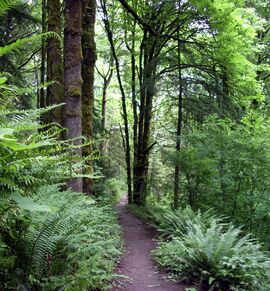
Parks and greenspace planning date back to John Charles Olmsted's 1903 Report to the Portland Park Board. In 1995, voters in the Portland metropolitan region passed a regional bond measure to acquire valuable natural areas for fish, wildlife, and people.[99] Ten years later, more than 8,100 acres (33 km2) of ecologically valuable natural areas had been purchased and permanently protected from development.[100]
Portland is one of only four cities in the U.S. with extinct volcanoes within its boundaries (along with Pilot Butte in Bend, Oregon, Jackson Volcano in Jackson, Mississippi, and Diamond Head in Honolulu, Hawaii). Mount Tabor Park is known for its scenic views and historic reservoirs.[101]
Forest Park is the largest wilderness park within city limits in the United States, covering more than 5,000 acres (2,023 ha).[102] Portland is also home to Mill Ends Park, the world's smallest park (a two-foot-diameter circle, the park's area is only about 0.3 m2). Washington Park is just west of downtown and is home to the Oregon Zoo, Hoyt Arboretum, the Portland Japanese Garden, and the International Rose Test Garden. Portland is also home to Lan Su Chinese Garden (formerly the Portland Classical Chinese Garden), an authentic representation of a Suzhou-style walled garden. Portland's east side has several formal public gardens: the historic Peninsula Park Rose Garden, the rose gardens of Ladd's Addition, the Crystal Springs Rhododendron Garden, the Leach Botanical Garden, and The Grotto.
Portland's downtown features two groups of contiguous city blocks dedicated for park space: the North and South Park Blocks.[103][104] The 37-acre (15 ha) Tom McCall Waterfront Park was built in 1974 along the length of the downtown waterfront after Harbor Drive was removed; it now hosts large events throughout the year.[105] The nearby historically significant Burnside Skatepark and five indoor skateparks give Portland a reputation as possibly "the most skateboard-friendly town in America."[106]
Tryon Creek State Natural Area is one of three Oregon State Parks in Portland and the most popular; its creek has a run of steelhead. The other two State Parks are Willamette Stone State Heritage Site, in the West Hills, and the Government Island State Recreation Area in the Columbia River near Portland International Airport.
Portland's city park system has been proclaimed one of the best in America. In its 2013 ParkScore ranking, the Trust for Public Land reported Portland had the seventh-best park system among the 50 most populous U.S. cities.[107] In February 2015, the City Council approved a total ban on smoking in all city parks and natural areas and the ban has been in force since July 1, 2015. The ban includes cigarettes, vaping, as well as marijuana.[108]
الاقتصاد
Portland's location is beneficial for several industries. Relatively low energy cost, accessible resources, north–south and east–west Interstates, international air terminals, large marine shipping facilities, and both west coast intercontinental railroads are all economic advantages.[109]
The city's marine terminals alone handle over 13 million tons of cargo per year, and the port is home to one of the largest commercial dry docks in the country.[110][111] The Port of Portland is the third-largest export tonnage port on the west coast of the U.S., and being about 80 miles (130 km) upriver, it is the largest fresh-water port.[109]
The scrap steel industry's history in Portland predates World War II. By the 1950s, the scrap steel industry became the city's number one industry for employment. The scrap steel industry thrives in the region, with Schnitzer Steel Industries, a prominent scrap steel company, shipping a record 1.15 billion tons of scrap metal to Asia during 2003. Other heavy industry companies include ESCO Corporation and Oregon Steel Mills.[112][113]
Technology is a major component of the city's economy, with more than 1,200 technology companies existing within the metro.[109] This high density of technology companies has led to the nickname Silicon Forest being used to describe the Portland area, a reference to the abundance of trees in the region and to the Silicon Valley region in Northern California.[114] The area also hosts facilities for software companies and online startup companies, some supported by local seed funding organizations and business incubators.[115] Computer components manufacturer Intel is the Portland area's largest employer, providing jobs for more than 15,000 people, with several campuses to the west of central Portland in the city of Hillsboro.[109]
The Portland metro area has become a business cluster for athletic/outdoor gear and footwear manufacturer's headquarters. Shoes are not manufactured in Portland.[116] The area is home to the global, North American or U.S. headquarters of Nike (the only Fortune 500 company headquartered in Oregon), Adidas, Columbia Sportswear, LaCrosse Footwear, Dr. Martens, Li-Ning,[117] Keen,[118] and Hi-Tec Sports.[119] While headquartered elsewhere, Merrell, Amer Sports and Under Armour have design studios and local offices in the Portland area.
Other notable Portland-based companies include industrial goods and metal fabrication company Precision Castparts, film animation studio Laika; commercial vehicle manufacturer Daimler Trucks North America; advertising firm Wieden+Kennedy; bankers Umpqua Holdings; child care and early childhood education provider KinderCare Learning Centers; and retailers Fred Meyer, New Seasons Market, and Storables.
Breweries are another major industry in Portland, which is home to 139 breweries/microbreweries, the 7th most in the nation, as of December 2018.[120] Additionally, the city boasts a robust coffee culture that now rivals Seattle and hosts over 20 coffee roasters.[121]
الإسكان
In 2016, home prices in Portland grew faster than in any other city in the United States.[122] Apartment rental costs in Portland reported in November 2019 was $1,337 for two bedroom and $1,133 for one bedroom.[123]
In 2017, developers projected an additional 6,500 apartments to be built in the Portland Metro Area over the next year.[124] However, as of December 2019, the number of homes available for rent or purchase in Portland continues to shrink. Over the past year, housing prices in Portland have risen 2.5%. Housing prices in Portland continue to rise, the median price rising from $391,400 in November 2018 to $415,000 in November 2019.[125] There has been a rise of people from out of state moving to Portland, which impacts housing availability. Because of the demand for affordable housing and influx of new residents, more Portlanders in their 20s and 30s are still living in their parents' homes.[126]
الفنون والثقافة
Music, film, and performing arts
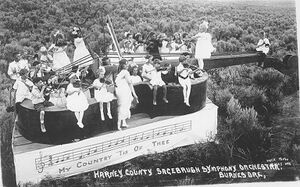
Portland is home to a range of classical performing arts institutions including the Portland Opera, Portland Baroque Orchestra, Oregon Symphony and Portland Youth Philharmonic; the last of these, established in 1924, was the first youth orchestra established in the United States.[127] The city is also home to several theaters and performing arts institutions including the Oregon Ballet Theatre, Northwest Children's Theatre, Portland Center Stage, Artists Repertory Theatre, Curious Comedy Theatre and Miracle Theatre.
In 2013, The Guardian named the city's music scene as one of the "most vibrant" in the United States.[128] Portland is home to famous bands such as the Kingsmen and Paul Revere & the Raiders, both famous for their association with the song "Louie Louie" (1963).[129] Other widely known musical groups include the Dandy Warhols, Quarterflash, Everclear, Pink Martini, Sleater-Kinney, Blitzen Trapper, the Decemberists, and the late Elliott Smith. More recently, Portugal. The Man, Modest Mouse, and the Shins have made their home in Portland. In the 1980s, the city was home to a burgeoning punk scene, which included bands such as the Wipers and Dead Moon.[130] The city's now-demolished Satyricon nightclub was a punk venue notorious for being the place where Nirvana frontman Kurt Cobain first encountered his future wife and Hole frontwoman Courtney Love in 1990.[131] Love was then a resident of Portland and started several bands there with Kat Bjelland, later of Babes in Toyland.[132][133] Multi-Grammy award-winning jazz artist Esperanza Spalding is from Portland and performed with the Chamber Music Society of Oregon at a young age.[134]
A wide range of films have been shot in Portland, from various independent features to major big-budget productions. Director Gus Van Sant has notably set and shot many of his films in the city.[135] The city has also been featured in various television programs, notably the IFC sketch comedy series Portlandia. The series, which ran for eight seasons from 2011 to 2018,[136] was shot on location in Portland, and satirized the city as a hub of liberal politics, organic food, alternative lifestyles, and anti-establishment attitudes.[137] MTV's long-time running reality show The Real World was also shot in Portland for the show's 29th season: The Real World: Portland premiered on MTV in 2013.[138] Other television series shot in the city include Leverage, The Librarians,[139] Under Suspicion, Grimm, and Nowhere Man.[140]
An unusual feature of Portland entertainment is the large number of movie theaters serving beer, often with second-run or revival films.[141] Notable examples of these "brew and view" theaters include the Bagdad Theater and Pub, a former vaudeville theater built in 1927 by Universal Studios;[142] Cinema 21; and the Laurelhurst Theater, in operation since 1923. Portland hosts the world's longest-running H. P. Lovecraft Film Festival[143] at the Hollywood Theatre.[144]
Museums and recreation
Portland is home to numerous museums and educational institutions, ranging from art museums to institutions devoted to science and wildlife. Among the science-oriented institutions are the Oregon Museum of Science and Industry (OMSI), which consists of five main halls and other ticketed attractions, such as the يوإسإس Blueback submarine,[145] the ultra-large-screen Empirical Theater (which replaced an OMNIMAX theater in 2013),[146] and the Kendall Planetarium.[147] The World Forestry Center Discovery Museum, located in the city's Washington Park area, offers educational exhibits on forests and forest-related subjects. Also located in Washington Park are the Hoyt Arboretum, the International Rose Test Garden, the Japanese Garden, and the Oregon Zoo.[148]
The Portland Art Museum owns the city's largest art collection and presents a variety of touring exhibitions each year and, with the recent addition of the Modern and Contemporary Art wing, it became one of the United States' 25 largest museums. The Oregon Historical Society Museum, founded in 1898, which has a variety of books, film, pictures, artifacts, and maps dating back throughout Oregon's history. It houses permanent and temporary exhibits about Oregon history, and hosts traveling exhibits about the history of the United States.[149]
Oaks Amusement Park, in the Sellwood district of Southeast Portland, is the city's only amusement park and is also one of the country's longest-running amusement parks. It has operated since 1905 and was known as the "Coney Island of the Northwest" upon its opening.[150]
Cuisine and breweries
Food carts are extremely popular within the city, with over 600 licensed carts.[151][152] The city is home to Stumptown Coffee Roasters as well as dozens of other micro-roasteries and cafes.[153]
Portland has 58 active breweries within city limits,[154] and 70+ within the surrounding metro area.[154] and data compiled by the Brewers Association ranks Portland seventh in the United States as of 2018.[155]
Portland hosts a number of festivals throughout the year that celebrate beer and brewing, including the Oregon Brewers Festival, held in Tom McCall Waterfront Park. Held each summer during the last full weekend of July, it is the largest outdoor craft beer festival in North America, with over 70,000 attendees in 2008.[156] Other major beer festivals throughout the calendar year include the Spring Beer and Wine Festival in April, the North American Organic Brewers Festival in June, the Portland International Beerfest in July,[157] and the Holiday Ale Festival in December.
Sustainability
The city became a pioneer of state-directed metropolitan planning, a program which was instituted statewide in 1969 to compact the urban growth boundaries of the city.[158] Portland was the first city to enact a comprehensive plan to reduce carbon dioxide emissions.[159]
Free speech and public nudity
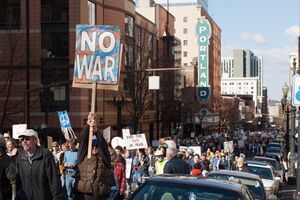
Strong free speech protections of the Oregon Constitution upheld by the Oregon Supreme Court in State v. Henry,[160] specifically found that full nudity and lap dances in strip clubs are protected speech.[161] Portland has the highest number of strip clubs per-capita in a city in the United States, and Oregon ranks as the highest state for per-capita strip clubs.[162]
In November 2008, a Multnomah County judge dismissed charges against a nude bicyclist arrested on June 26, 2008. The judge stated that the city's annual World Naked Bike Ride – held each year in June since 2004 – has created a "well-established tradition" in Portland where cyclists may ride naked as a form of protest against cars and fossil fuel dependence.[163] The defendant was not riding in the official World Naked Bike Ride at the time of his arrest as it had occurred 12 days earlier that year, on June 14.[164]
Protests
From November 10 to 12, 2016, protests in Portland turned into a riot, when a group broke off from a larger group of peaceful protesters who were opposed to the election of Donald Trump as president of the United States.[165][166]
Public art
العقارات
النقل
الحكومة
The city of Portland is governed by the Portland City Council, which includes a mayor, four commissioners, and an auditor. Each is elected citywide to serve a four-year term. Each commissioner oversees one or more bureaus responsible for the day-to-day operation of the city. The mayor serves as chairman of the council and is principally responsible for allocating department assignments to his fellow commissioners. The auditor provides checks and balances in the commission form of government and accountability for the use of public resources. In addition, the auditor provides access to information and reports on various matters of city government. Portland is the only large city left in the United States with the commission form of government.[167]
The city's Community & Civic Life (formerly Office of Neighborhood Involvement)[169] serves as a conduit between city government and Portland's 95 officially recognized neighborhoods. Each neighborhood is represented by a volunteer-based neighborhood association which serves as a liaison between residents of the neighborhood and the city government. The city provides funding to neighborhood associations through seven district coalitions, each of which is a geographical grouping of several neighborhood associations. Most (but not all) neighborhood associations belong to one of these district coalitions.
Portland and its surrounding metropolitan area are served by Metro, the United States' only directly elected metropolitan planning organization. Metro's charter gives it responsibility for land use and transportation planning, solid waste management, and map development. Metro also owns and operates the Oregon Convention Center, Oregon Zoo, Portland Center for the Performing Arts, and Portland Metropolitan Exposition Center.
The Multnomah County government provides many services to the Portland area, as do Washington and Clackamas counties to the west and south.
Fire and emergency services are provided by Portland Fire & Rescue.
On November 8, 2022, Portland residents approved a charter reform ballot measure to replace the commission form of government with a 12-member council elected in four districts using single transferable vote, with a professional city manager appointed by a directly-elected mayor. The city expects to hold the first election for this new system in 2024.[170]
التخطيط والتنمية
The city consulted with urban planners as far back as 1904, resulting in the development of Washington Park and the 40-Mile Loop greenway, which connects many of the city's parks.[171] Portland is often cited as an example of a city with strong land use planning controls.[172] This is largely the result of statewide land conservation policies adopted in 1973 under Governor Tom McCall, in particular the requirement for an urban growth boundary (UGB) for every city and metropolitan area. The opposite extreme, a city with few or no controls, is typically illustrated by Houston.[173][174][175][176]
Oregon's 1973 "urban growth boundary" law limits the boundaries for large-scale development in each metropolitan area in Oregon.[177] This limits access to utilities such as sewage, water and telecommunications, as well as coverage by fire, police and schools.[177] Portland's urban growth boundary, adopted in 1979, separates urban areas (where high-density development is encouraged and focused) from traditional farm land (where restrictions on non-agricultural development are very strict).[178] This was atypical in an era when automobile use led many areas to neglect their core cities in favor of development along interstate highways, in suburbs, and satellite cities.
The original state rules included a provision for expanding urban growth boundaries, but critics felt this was not being accomplished. In 1995, the State passed a law requiring cities to expand UGBs to provide enough undeveloped land for a 20-year supply of future housing at projected growth levels.[179] In 2007, the legislature changed the law to require the maintenance of an estimated 50 years of growth within the boundary, as well as the protection of accompanying farm and rural lands.[180] The growth boundary, along with efforts of the Portland Development Commission to create economic development zones, has led to the development of a large portion of downtown, a large number of mid- and high-rise developments, and an overall increase in housing and business density.[181]
Prosper Portland (formerly the Portland Development Commission) is a semi-public agency that plays a major role in downtown development; city voters created it in 1958 to serve as the city's urban renewal agency. It provides housing and economic development programs within the city and works behind the scenes with major local developers to create large projects. In the early 1960s, the Portland Development Commission led the razing of a large Italian-Jewish neighborhood downtown, bounded roughly by I-405, the Willamette River, 4th Avenue and Market street.[182] Mayor Neil Goldschmidt took office in 1972 as a proponent of bringing housing and the associated vitality back to the downtown area, which was seen as emptying out after 5 pm. The effort has had dramatic effects in the 30 years since, with many thousands of new housing units clustered in three areas: north of Portland State University (between I-405, SW Broadway, and SW Taylor St.); the RiverPlace development along the waterfront under the Marquam (I-5) bridge; and most notably in the Pearl District (between I-405, Burnside St., NW Northrup St., and NW 9th Ave.).
Historically, environmental consciousness has weighed significantly in the city's planning and development efforts.[183] Portland was one of the first cities in the United States to promote and integrate alternative forms of transportation, such as the MAX Light Rail and extensive bike paths.[183] The Urban Greenspaces Institute, housed in Portland State University Geography Department's Center for Mapping Research, promotes better integration of the built and natural environments. The institute works on urban park, trail, and natural areas planning issues, both at the local and regional levels.[184] In October 2009, the Portland City Council unanimously adopted a climate action plan that will cut the city's greenhouse gas emissions to 80% below 1990 levels by 2050.[185]
As of 2012, Portland was the largest city in the United States that did not add fluoride to its public water supply,[186] and fluoridation has historically been a subject of controversy in the city.[187] Portland voters have four times voted against fluoridation, in 1956, 1962, 1980 (repealing a 1978 vote in favor), and 2013.[188] In 2012 the city council, responding to advocacy from public health organizations and others, voted unanimously to begin fluoridation by 2014. Fluoridation opponents forced a public vote on the issue,[189] and on May 21, 2013, city voters again rejected fluoridation.[190]
التعليم
المدن الشقيقة
معرض الصور
1897 topographic map of Portland shows streets, railroads, and significant differences in the Columbia Slough
MAX Light Rail and underground station at the Oregon Zoo
A view of the Willamette River from the Roof of the KOIN Center
انظر أيضا
- قائمة أشخاص من پورتلاند، اوريگون
- 1972 Portland-Vancouver Tornado
- قائمة مستشفيات پورتلاند، اوريگون
- 1972 Portland–Vancouver tornado
- Keep Portland Weird
- List of hospitals in Portland, Oregon
- List of sports venues in Portland, Oregon
- Roman Catholic Archdiocese of Portland in Oregon
- Roses in Portland, Oregon
- USS Portland, 2 of 3 ships
ملاحظات
- ^ According to the U.S. Census Bureau, Oregon's population, as of 2019, was 4,217,737; the portion of the MSA that lies in Oregon has a population of 1,992,088, which leaves 47% of Oregon's population residing within the metro.
- ^ Mean monthly maxima and minima (i.e. the highest and lowest temperature readings during an entire month or year) calculated based on data at said location from 1991 to 2020.
- ^ Official records for Portland have been kept at PDX since October 13, 1940.[93] In January 1996, snow measurements for PDX were moved to the NWS Portland office 4 mi (6.4 km) to the east at 5241 NE 122nd Avenue, Portland, OR 97230-1089.[84]
المصادر
- ^ أ ب "Portland: The Town that was Almost Boston". National Association of Scientific Materials Managers. Archived from the original on July 27, 2013. Retrieved March 7, 2013.
- ^ "City Home". City of Portland, Oregon. 2017. Retrieved January 2, 2017.
- ^ "2019 U.S. Gazetteer Files". United States Census Bureau. Retrieved July 28, 2020.
- ^ The highest elevation is at 9936 NW Wind Ridge Dr., 45°33′31″N 122°46′43″W / 45.55873°N 122.77854°W. "City of Portland Urban Services Area". Bureau of Planning and Sustainability. Retrieved October 30, 2015.
- ^ The lowest elevation historically occurred at low water on January 17, 1937 at the confluence of the Columbia and Willamette Rivers 45°39′03″N 122°45′46″W / 45.65096°N 122.76289°W. "Advanced Hydrologic Prediction Service: Portland: Columbia River at Vancouver". Water.weather.gov. Retrieved September 6, 2013.
- ^ "2020 Population and Housing State Data". United States Census Bureau. Retrieved August 22, 2021.
- ^ "US Board on Geographic Names". United States Geological Survey. October 25, 2007. Retrieved January 31, 2008.
- ^ "QuickFacts: Portland city, Oregon" (in الإنجليزية الأمريكية). United States Census Bureau. Retrieved August 21, 2021.
{{cite web}}: CS1 maint: url-status (link) - ^ Danver, Steven L., ed. (2013). Encyclopedia of Politics of the American West. CQ Press. pp. 533–34. ISBN 978-1-506-35491-0.
- ^ Baker, Emerson W. (2005). "Portland as a Contested Frontier in the Seventeenth Century". In Conforti, Joseph A. (ed.). Creating Portland: History and Place in Northern New England. Lebanon, NH: University of New Hampshire Press. p. 16. ISBN 978-1584654490. Retrieved April 21, 2018.
- ^ أ ب Olsen, Polina (2012). Portland in the 1960s: Stories from the Counterculture. Charleston, South Carolina: The History Press. ISBN 978-1-60949-471-1.
- ^ Weber, Peter (January 13, 2015). "Don't let Portlandia ruin Portland". The Week. Retrieved October 30, 2015.
- ^ Berg, Nate (March 1, 2012). "The Only Elected Regional Government in the U.S." CityLab. Bloomberg L.P. Retrieved February 25, 2015.
- ^ Ramakrishnan, Ramakrishnan (2022-04-22). "Metro Council president faces challenge from longtime urban planner". oregonlive (in الإنجليزية). Retrieved 2022-10-26.
- ^ أ ب Swindler, Samantha (May 31, 2020). "Though the rose show and garden contest are canceled, the City of Roses is in full bloom". The Oregonian (in الإنجليزية). Retrieved October 19, 2020.
- ^ Allen, Burns & Sargent 2009.
- ^ Marschner 2008, p. 187.
- ^ أ ب ت Anderson, Susan (2009). "East Portland Historical Overview & Historic Preservation Study". City of Portland Bureau of Planning and Sustainability. Archived from the original on January 1, 2016. Retrieved October 30, 2015.
- ^ "First Year in Oregon, 1840-1869: A Narrative History (U.S. National Park Service)". www.nps.gov (in الإنجليزية). Retrieved 2022-08-25.
- ^ Scott 1890, p. 61.
- ^ Orloff, Chet (2004). "Maintaining Eden: John Charles Olmsted and the Portland Park System". Yearbook of the Association of Pacific Coast Geographers. 66: 114–19. doi:10.1353/pcg.2004.0006. S2CID 129896123.
- ^ "Overton Cabin". Oregon History Project. Archived from the original on November 17, 2015. Retrieved October 29, 2015.
- ^ Gibson, Campbell (June 1998). Population of the 100 Largest Cities and Other Urban Places in the United States: 1790 to 1990. U.S. Bureau of the Census – Population Division.
- ^ Scott 1890, p. 160.
- ^ Consumer Price Index (estimate) 1800–2008. Federal Reserve Bank of Minneapolis. Retrieved December 7, 2010.
- ^ Loy, William G.; Stuart Allan; Aileen R. Buckley; James E. Meacham (2001). Atlas of Oregon. University of Oregon Press. pp. 32–33. ISBN 978-0-87114-101-9.
- ^ "Historical Timeline". Portland Online. Retrieved October 30, 2015.
- ^ "City keeps lively pulse". (Spencer Heinz, The Oregonian, January 23, 2001)
- ^ "Portland's Japantown".
- ^ Roos, Roy E. (January 8, 2010). "The White Eagle Saloon". Eliot Neighborhood. Retrieved October 30, 2015.
- ^ أ ب ت John 2012, p. 16.
- ^ John 2012, p. 10.
- ^ MacColl, E. Kimbark (November 1976). The Shaping of a City: Business and Politics in Portland, Oregon 1885 to 1915. Portland, Oregon: The Georgian Press Company. OCLC 2645815.
- ^ Kennedy, Sarah. "The Shanghai Tunnels". The New York Times. Retrieved September 26, 2014.
- ^ Chandler 2013.
- ^ خطأ استشهاد: وسم
<ref>غير صحيح؛ لا نص تم توفيره للمراجع المسماةDecennialCensus - ^ أ ب "'Return & Remembrance': In Commemoration of the 75th Anniversary of E.O. 9066," Pacific Citizen, June 2–15, 2017, p. 4
- ^ "Portland (detention facility)". Densho Encyclopedia.
- ^ أ ب Ellis, Janey. "Portland's Dirty Little Secret: How Vice and Corruption Held the Rose City In Its Clutches" (PDF). Oregon History. Archived from the original (PDF) on January 18, 2016. Retrieved October 30, 2015.
- ^ أ ب Toll, William (2003). "Home Front Boom". Oregon Historical Society. Archived from the original on June 9, 2011. Retrieved October 30, 2015.
- ^ أ ب "The 1960s". Oregon Live. An Oregon Century. Retrieved October 30, 2015.
- ^ "The 1970s". Oregon Live. An Oregon Century. Retrieved October 30, 2015.
- ^ "The 1990s". An Oregon Century. Retrieved October 30, 2015.
- ^ "Annual Estimates of the Resident Population for Incorporated Places: April 1, 2010 to July 1, 2014". Archived from the original on May 23, 2015. Retrieved June 4, 2015.
- ^ أ ب Miller, Clair Cane (September 16, 2014). "Will Portland Always Be a Retirement Community for the Young?". The New York Times. Retrieved November 6, 2015.
- ^ "City Flower". City of Portland Auditor's Office – City Recorder Division. Archived from the original on April 23, 2009.
- ^ أ ب Stern, Henry (June 19, 2003). "Name comes up roses for P-town: City Council sees no thorns in picking 'City of Roses' as Portland's moniker". The Oregonian
- ^ أ ب "The Water". Portland State University. Archived from the original on October 31, 2006. Retrieved November 7, 2006.
- ^ "From Robin's Nest to Stumptown". End of the Oregon Trail Interpretive Center. February 1, 2013. Archived from the original on May 12, 2013. Retrieved March 7, 2013.
- ^ Baker, Nena (May 21, 1991). "R.I.P. FOR 'Rip City' Ruckus". The Oregonian. pp. A01.
- ^ Sandomir, Richard (November 6, 2008). "Seeking Help to Bring an M.L.S. Team to Portland". The New York Times. Retrieved June 22, 2010.
- ^ Dure, Beau (August 26, 2009). "Portland Timbers show bark, bite as they prepare to join MLS". USA Today. McLean, Virginia. Retrieved June 22, 2010.
- ^ Hagestedt, Andre (April 7, 2009). "The Missing Oregon Coast: Waves After Dark". Retrieved April 30, 2009.
I'm used to seeing that hint of dawn back in P-town, with my wretched habit of playing video games until 6 a.m
- ^ McCall, William (August 19, 2003). "'Little Beirut' nickname has stuck". Associated Press. Retrieved September 16, 2013.
- ^ Baker, Mike (April 27, 2021). "After Nearly a Year of Unrest, Portland Leaders Pursue a Crackdown". The New York Times. Archived from the original on December 28, 2021. Retrieved May 2, 2021.
- ^ Vice, Staff (September 23, 2020). "Man Linked to Killing at a Portland Protest Says He Acted in Self-Defense". Vice. Retrieved September 23, 2020.
- ^ Evans, Robert (July 20, 2020). "What You Need To Know About The Battle of Portland". Bellingcat (in الإنجليزية البريطانية). Retrieved August 2, 2020.
- ^ Hughes, Trevor (July 26, 2020). "Portland police declare riot as demonstrators attack fence outside federal courthouse". USA Today. Retrieved August 2, 2020.
- ^ Kavanaugh, Shane (July 30, 2020). "Man knifed in back at Portland protest: 'I was stabbed for being a conservative journalist'". The Oregonian. Retrieved August 2, 2020.
- ^ VanderHart, Dirk; Levinson, Jonathan; Ellis, Rebecca; Orr, Donald (May 31, 2020). "As Protests Continue, Civic Leaders Confront Crowds And Oregon's Racist History". Oregon Public Broadcasting. Archived from the original on June 3, 2020. Retrieved June 1, 2020.
- ^ Green, Aimee (June 10, 2020). "Portland now faces 8 lawsuits seeking an end to tear gas, rubber bullets, explosives at protests". The Oregonian. Archived from the original on August 1, 2020. Retrieved August 2, 2020.
- ^ Ellis, Rebecca (July 17, 2020). "ACLU Adds Federal Agencies To Lawsuit Against Portland Police". Oregon Public Broadcasting (in الإنجليزية). Retrieved August 2, 2020.
- ^ "Oregon AG files lawsuit against federal agencies for violating Oregonians' civil rights". KGW (in الإنجليزية الأمريكية). July 17, 2020. Retrieved August 2, 2020.
- ^ Flanigan, Kaitlin (July 27, 2020). "Lawsuit: Trump using feds in Portland to create national police force". Koin.com. Retrieved August 2, 2020.
- ^ "Police declare riot in Portland as protesters mark 1 year since George Floyd's death". ABC News (in الإنجليزية). Retrieved May 26, 2021.
- ^ "Riot declared in downtown Portland, police arrest 5 people". KPTV.com (in الإنجليزية). Archived from the original on November 1, 2021. Retrieved May 26, 2021.
- ^ "The Boring Lava Field, Portland, Oregon". USGS Cascades Volcano Observatory. Retrieved November 7, 2006.
- ^ "Mount Tabor Cinder Cone, Portland, Oregon". USGS Cascades Volcano Observatory. Retrieved April 20, 2007.
- ^ Nokes, R. Gregory (December 4, 2000). "History, relived saved from St. Helens by a six-pack of Fresca". The Oregonian. p. 17.
- ^ Trimble, Donald (1963). Geology of Portland, Oregon and Adjacent Areas (PDF). Geological Survey Bulletin. pp. 1–2.
- ^ أ ب Banse, Tom (November 21, 2017). "Geologists Keep Finding More Northwest Earthquake Faults". Oregon Public Broadcasting. Archived from the original on May 10, 2018. Retrieved May 10, 2018.
- ^ Rojas-Burke, Joe (February 23, 2011). "Comparing Portland's quake risk to that of devastated Christchurch, New Zealand". The Oregonian. Retrieved May 9, 2018.
- ^ Mesh, Aaron (January 26, 2010). "Quake-Up Call". Willamette Week. Retrieved May 9, 2018.
- ^ Bott, Jacqueline D.J.; Wong, Ivan G. (September 1993). "Historical Earthquakes in and around Portland, Oregon". Oregon Geology. 55 (5): 116.
- ^ McDonough, P. W., ed. (2002). The Nisqually, Washington, Earthquake of February 28, 2001. Open-File Report 2002-346. American Society of Civil Engineers. pp. 28, 29. ISBN 978-0-7844-7516-4.
- ^ Cassuto, Dan (March 24, 2014). "7,000 high-risk landslide zones in Portland area; check if you live in one". KATU. Archived from the original on February 7, 2017. Retrieved May 9, 2018.
- ^ Hale, Jamie (April 28, 2016). "Council Crest hike is well worth the extra effort". The Oregonian (in الإنجليزية). Retrieved August 15, 2020.
- ^ "US Gazetteer files 2010". United States Census Bureau. Archived from the original on July 2, 2012. Retrieved December 21, 2012.
- ^ Anderson 2014, p. 138.
- ^ "Global Ecological Zoning for the Global Forest Resources Assessment 2000". Forestry Department of the Food and Agriculture Organization. 2001. Retrieved September 12, 2012.
- ^ أ ب "Portland Airport (Oregon): Normals, means, and extremes". National Oceanic and Atmospheric Administration. Retrieved September 12, 2012.
- ^ أ ب ت ث ج ح "NowData – NOAA Online Weather Data". National Oceanic and Atmospheric Administration. Retrieved April 11, 2016.
- ^ "Has The Snow Finally Stopped?". fivethirtyeight.com. March 10, 2015.
- ^ أ ب "AIRPORT Portland: Monthly and Seasonal Snowfall (inches)" (PDF). NWS Portland, OR. Retrieved June 22, 2014.
- ^ "Downtown Portland: Monthly and Seasonal Snowfall (inches)" (PDF). NWS Portland, Oregon. Archived from the original (PDF) on January 19, 2016. Retrieved June 22, 2014.
- ^ "Best Times to Visit Portland, OR". U.S. News & World Report. Retrieved November 11, 2015.
- ^ "Portland weather hits 90 degrees for record 31st day in 2018". The Oregonian. September 6, 2018. Retrieved September 6, 2018.
- ^ Williams, Kale (June 29, 2021). "Portland's record-breaking heat wave: by the numbers". The Oregonian. Retrieved May 18, 2023.
- ^ Goldberg, Jamie; Ramakrishnan, Jayati (June 29, 2021). "Portland records all-time high temperature of 116, setting new record for third day in a row". The Oregonian. Retrieved May 18, 2023.
- ^ Perry, Douglas (June 24, 2021). "Portland could set heat record this weekend, despite June's history as city's summer golden period". The Oregonian. Retrieved May 18, 2023.
- ^ Mass 2008, p. 138.
- ^ "Why Doesn't the West Coast See Thunderstorms?". Archived from the original on April 27, 2016. Retrieved April 19, 2016.
- ^ "Threaded Extremes". threadex.rcc-acis.org.
- ^ "Station Name: OR PORTLAND INTL AP". National Oceanic and Atmospheric Administration. Retrieved March 13, 2014.
- ^ "WMO Climate Normals for PORTLAND OR 1961–1990". National Oceanic and Atmospheric Administration. Retrieved July 18, 2020.
- ^ "Portland, Oregon, USA - Monthly weather forecast and Climate data". Weather Atlas. Retrieved June 14, 2019.
- ^ Newcomb, Tim (August 20, 2015). "You Can't Drive Across This Gorgeous Bridge". Popular Mechanics (in الإنجليزية الأمريكية). Retrieved January 14, 2021.
- ^ "NOW Data-NOAA Online Weather Data". National Oceanic and Atmospheric Administration. 2009. Retrieved 2009-07-30.
- ^ "Parks and nature investments". OregonMetro.Gov. Retrieved October 31, 2015.
- ^ Houck, Mike. "Metropolitan Greenspaces: A Grassroots Perspective". Audubon Society of Portland. Archived from the original on September 28, 2007. Retrieved November 7, 2006.
- ^ "Mount Tabor Park". Portland Parks & Recreation. Retrieved November 7, 2006.
- ^ Korn, Peter (July 18, 2006). "Forest Park Fallacy: Boosters' Claim of 'Largest Forested City Park' Is Long Outdated". Portland Tribune. Pamplin Media Group.
- ^ "North Park Blocks". The City of Portland, Oregon. Retrieved May 11, 2016.
- ^ "South Park Blocks". The City of Portland, Oregon. Retrieved May 11, 2016.
- ^ "Waterfront Park Master Plan" (PDF). Portland, Oregon. p. 54. Retrieved May 11, 2016.
- ^ Dougherty, Conor (July 30, 2009). "Skateboarding Capital of the World". The Wall Street Journal. Retrieved July 31, 2009.
- ^ Belz, Kristin. "New York Parks Rank No. 2 in a Survey of 50 U.S. cities". June 12, 2013. Portland Monthly Magazine. Retrieved July 18, 2013.
- ^ Andrew Theen | The Oregonian/OregonLive (February 19, 2015). "No smoking allowed: Portland City Council approves smoking ban for city parks, nature areas". The Oregonian (in الإنجليزية). Retrieved August 15, 2020.
- ^ أ ب ت ث "Portland: Economy – Major Industries and Commercial Activity". Retrieved June 4, 2008.
- ^ "Cascade General, Inc". Answers.com. Retrieved June 4, 2008.
- ^ "Portfolio" (PDF). Archived from the original (PDF) on يناير 15, 2013. Retrieved يونيو 4, 2008.
- ^ "Profile". Schnitzer Steel Industries. Retrieved March 9, 2013.
- ^ "About Us". ESCO Corporation. Archived from the original on February 13, 2021. Retrieved March 9, 2013.
- ^ Rogoway, Mike (April 9, 2006). Bizz blog: Silicon Forest. The Oregonian.
- ^ Gage, Deborah (January 23, 2012). "Portland Makes Bid To Become Budding Techlandia". Venture Capital Dispatch.
- ^ Korfhage, Matthew (January 26, 2016). "Everything You Need to Know About the Portland Shoe Industry". Willamette Week. Retrieved May 3, 2017.
- ^ Gregory, Roger (January 21, 2008). "Top Chinese shoemaker opens U.S. headquarters in Portland" (January 21, 2008). The Oregonian. Retrieved September 14, 2013.
- ^ Duxbury, Sarah (November 13, 2005). "Footwear firm gives Bay Area the boot". San Francisco Business Times. Retrieved September 14, 2013.
- ^ Brettman, Allan (October 10, 2010). "Hi-Tec moving U.S. headquarters to Portland". October 10, 2010. Retrieved September 14, 2013.
- ^ "Chicago is home to more breweries than any other US city". Chicago Sun-Times (in الإنجليزية). December 13, 2018. Retrieved March 3, 2019.
- ^ "Coffee made in Portland, Oregon". MadeInPortland.org. Retrieved September 10, 2017.
- ^ "Zillow: Portland area leads nation in home-price increases, second in rent hikes". The Oregonian (in الإنجليزية الأمريكية). Retrieved February 14, 2017.
- ^ Eastman, Janet (November 17, 2019). "Portland rents are holding steady with two-bedroom units at $1,337 a month". The Oregonian (in الإنجليزية). Retrieved October 23, 2020.
- ^ "Sick of Portland Changing? Too Bad. Here Are 7 Places Where This City Could Soon Go Big".
- ^ "Portland-area homebuyers face even fewer choices as prices rise 2.5% over last year". December 23, 2019.
- ^ "Portland's Housing Crisis Would be a Lot Worse if So Many 20- and 30- Somethings Weren't Living with Their Parents".
- ^ "Latest 'Oregon Experience' chronicles a violin teacher's legacy". The Oregonian. November 6, 2009. Retrieved March 31, 2018.
- ^ Rayburn, Aaron; Vickery, Ben (May 24, 2013). "Top 10 live music venues in Portland, Oregon". The Guardian. Retrieved November 11, 2015.
- ^ Ely, Jack. "The Kingsmen Homepage". The Kingsmen Online. Retrieved December 6, 2012.
- ^ Hann, Michael (January 20, 2015). "Cult heroes: Wipers – the sound of emptiness and dread". The Guardian. Retrieved September 12, 2015.
- ^ "Kurt Cobain". Biography.com. Archived from the original on January 14, 2012. Retrieved May 17, 2010.
- ^ Kennedy, Dana (August 12, 1994). "The Power of Love". Entertainment Weekly. Archived from the original on July 9, 2016. Retrieved October 20, 2010.
- ^ "Courtney Love". The E! True Hollywood Story. October 5, 2003. E!.
- ^ Hughley, Marty (February 11, 2011). "Esperanza Spalding didn't come out of the blue to beat Justin Bieber at the Grammys – she came from Portland's jazz community". Oregon Live. Retrieved November 3, 2015.
- ^ Falsetto 2015.
- ^ Scott, Aaron (January 18, 2018). "'Portlandia' Is Ending, And Portlanders Are OK With That". NPR. Retrieved March 30, 2018.
- ^ Mike Hsu (September 28, 2012). "Talking Portlandia With Fred Armisen". WAAF Radio. Archived from the original on September 21, 2013. Retrieved March 6, 2013.
- ^ Turnquist, Kristi (March 21, 2013). "MTV goes 'Real World' retro in run-up to 'The Real World: Portland'". The Oregonian. Retrieved March 31, 2018.
- ^ "TNT cancels Portland-filmed series, 'The Librarians'". The Oregonian. March 8, 2018. Retrieved March 31, 2018.
- ^ Turnquist, Kristi (November 22, 2017). "23 TV series set in Oregon, ranked: Most memorable to totally forgettable". The Oregonian.
- ^ "Portland brew 'n' view theaters". Travel Portland. July 26, 2013. Retrieved September 29, 2015.
- ^ Palahniuk 2003.
- ^ Ogden, Tom (2010). Haunted Hotels: Eerie Inns, Ghoulish Guests, and Creepy Caretakers. Globe Pequot Press. p. 10. ISBN 978-0762756599.
- ^ "Lovecraft Film Festival Official site". Retrieved November 25, 2007.
- ^ Pitawanich, Christine (December 19, 2017). "Fond memories aboard USS Blueback submarine featured at OMSI". KGW. Archived from the original on April 2, 2018. Retrieved April 2, 2018.
- ^ Mohan, Marc (September 5, 2013). "Omnimax says goodbye; Bagdad goes first-run: Indie theater news". The Oregonian. Retrieved April 1, 2018.
- ^ Anderson, John Gottberg (August 20, 2017). "Observatories and planetariums within a day's drive of Bend". The Bulletin. Bend, Oregon. Archived from the original on April 2, 2018. Retrieved April 1, 2018.
- ^ Hale, Jamie (May 11, 2016). "Portland hiking guide: The 20 best places to hike in the city". The Oregonian. Retrieved March 30, 2018.
- ^ "Oregon Historical Society Museum". Smithsonian. Archived from the original on April 2, 2018. Retrieved March 31, 2018.
- ^ Beck, Dana (December 20, 2012). "Oaks Amusement Park, and its beginnings". The Bee. Pamplin Media Group. Retrieved July 3, 2017.
- ^ "A Few Favorite Portland Food Carts". The Denver Post. Retrieved September 14, 2010.
- ^ Brett Burmeister (August 25, 2011). "Food carts for dessert". PortlandPulp. Archived from the original on September 11, 2015. Retrieved March 6, 2013.
- ^ Strand, Oliver (September 16, 2009). "A Seductive Cup". The New York Times. Retrieved October 15, 2009.
- ^ أ ب "Facts – Oregon Craft Beer". OregonCraftBeer.org. Archived from the original on February 27, 2015. Retrieved February 26, 2015.
- ^ "Brewery Growth is Both Urban and Rural". Brewers Association (in الإنجليزية الأمريكية). December 10, 2018. Retrieved July 25, 2019.
- ^ Foyston, John (July 29, 2008). "2008 OBF biggest ever". The Oregonian. Archived from the original on September 22, 2013.
- ^ Distefano, Anne Marie (July 8, 2005). "Brewers, beer lovers get many reasons to raise a glass". Portland Tribune. Archived from the original on December 6, 2008. Retrieved April 17, 2016.
- ^ Freilich, Sitkowski & Mennilo 2010, p. 134.
- ^ Kate Sheppard (July 19, 2007). "15 Green Cities". Environmental News and Commentary. Retrieved June 23, 2010.
- ^ قالب:Cite court
- ^ Busse, Phil (November 7, 2002). "Cover Yourself!". The Portland Mercury. Retrieved February 1, 2007.
- ^ Crockett, Zachary (June 17, 2015). "Why Does Portland Have so Many Strip Clubs?". Priceonomics. Retrieved April 1, 2018.
- ^ "Judge: riding in the buff is 'tradition,' man cleared". KATU. Associated Press. November 21, 2008. Archived from the original on January 22, 2009. Retrieved December 8, 2008.
- ^ "Pedalpalooza". 2008. Archived from the original on May 7, 2016. Retrieved May 7, 2016.
- ^ Camila Domonoske (November 11, 2016). "Anti-Trump Protest in Portland, Ore., Turns Destructive, Declared a Riot". NPR. Retrieved November 12, 2016.
Later in the evening, what appeared to be a small subgroup of self-described anarchists began to damage cars at a Toyota dealership and ignite fireworks, before moving through the Pearl District and damaging several businesses.
- ^ Pattiz, Will (2022-10-05). "Portland Protests Photos: What's Really Going on from a Local Portlander". EMBRACE SOMEPLACE (in الإنجليزية الأمريكية). Retrieved 2022-10-26.
- ^ "City Government Structure". City of Portland. Retrieved March 3, 2019.
The City of Portland has the last remaining Commission form of government among large cities in the United States.
- ^ "Pioneer courthouse's bare earth will soon sprout native plants". The Oregonian. October 12, 2006. Archived from the original on November 10, 2006. Retrieved January 21, 2007.
- ^ "Inside Civic Life | The City of Portland, Oregon". www.portlandoregon.gov. Retrieved March 3, 2019.
- ^ "Portland voters approve charter reform, city launches transition | Portland.gov". www.portland.gov (in الإنجليزية). 2022-11-09. Retrieved 2022-11-10.
- ^ "The 40-Mile Loop: More than a bike trail, and more than 40 miles". The Oregonian. September 30, 2009. Retrieved April 1, 2018.
- ^ "The 'Smart Growth' Debate Continues". Urban Mobility Corporation. May–June 2003. Archived from the original on March 6, 2012. Retrieved November 7, 2006.
- ^ "How Houston gets along without zoning – BusinessWeek". Bloomberg BusinessWeek. Archived from the original on March 6, 2008. Retrieved October 20, 2008.
- ^ Thomas, Sherry (October 30, 2003). "Houston: A city without zoning". USA Today. Archived from the original on January 16, 2013. Retrieved January 11, 2013.
- ^ Reinhold, Robert (August 17, 1986). "Focus Houston; A Fresh Approach To Zoning". The New York Times. Retrieved October 20, 2008.
- ^ Schadewald, Bill (April 9, 2006). "The only major U.S. city without zoning". Houston Business Journal. Retrieved October 20, 2008.
- ^ أ ب "Urban growth boundary". Metro. Retrieved February 26, 2013.
- ^ "Statewide Planning Goals". Oregon Department of Land Conservation and Development. Retrieved April 1, 2018.
- ^ "Comprehensive Land Use Planning Coordination". Legislative Counsel Committee of the Oregon Legislative Assembly. Retrieved January 28, 2019.
- ^ خطأ استشهاد: وسم
<ref>غير صحيح؛ لا نص تم توفيره للمراجع المسماةpt_growth - ^ "Portland – SkyscraperPage". Retrieved June 4, 2008.
- ^ Korfhage, Matthew (August 22, 2017). "Portland Once Had a Thriving Little Italy – What the Hell Happened?". Willamette Week. Retrieved April 1, 2018.
- ^ أ ب Hogdson, Beth (March 1, 2010). "Top 5 greenest cities in the world". Reuters. Archived from the original on March 4, 2010. Retrieved March 31, 2018 – via GlobalPost.
- ^ Platt 2006, p. 43.
- ^ Law, Steve (October 27, 2009). "Council adopts aggressive Climate Action Plan". Portland Tribune. Retrieved July 6, 2013.
- ^ Muskal, Michael (September 12, 2012). "Portland joins fluoride bandwagon, will add it to water supply". Los Angeles Times. Retrieved April 1, 2018.
- ^ Williams, Heidi (September 12, 2012). "Portland's fluoride debate: History, timeline and official positions". The Oregonian. Retrieved April 1, 2018.
- ^ Blumgart, Jake (May 17, 2013). "What's the Matter With Portland? The city has been fighting fluoridation for 50 years. Will facts trump fear this month?". Slate. Retrieved April 1, 2018.
- ^ Slovic, Beth (September 12, 2012). "Portland votes to add fluoride to its drinking water as opponents vow to stop the effort". The Oregonian. Retrieved April 1, 2018.
- ^ Kost, Ryan (May 21, 2013). "Portland fluoride: For the fourth time since 1956, Portland voters reject fluoridation". The Oregonian. Retrieved April 1, 2018.
قراءات أخرى
- C. Abbott, Greater Portland: Urban Life and Landscape in the Pacific Northwest. Philadelphia: University of Pennsylvania Press, 2001. ISBN 0-8122-1779-9
- C. Ozawa (Ed.), The Portland Edge: Challenges and Successes in Growing Communities. Washington: Island Press, 2004. ISBN 1-55963-695-5
- Chuck Palahniuk, Fugitives and Refugees: A Walk in Portland, Oregon. Crown, 2003. ISBN 1-4000-4783-8
- Stewart Holbrook, The Far Corner. Comstock Editions, 1952. ISBN 0-89174-043-0
- E. Kimbark MacColl, The Shaping of a City: Business and Politics in Portland, Oregon 1885 to 1915. Portland: Georgian Press, 1976. OCLC 2645815 قالب:ASIN
- E. Kimbark MacColl, The Growth of a City: Power and Politics in Portland, Oregon 1915 to 1950. Portland: Georgian Press, 1979. ISBN 0-9603408-1-5
- Jewel Lansing, Portland: People, Politics, and Power, 1851–2001. Oregon State University Press, 2003. ISBN 978-0870715594
- MacGibbon, Elma (1904). Leaves of knowledge. Shaw & Borden Co.
{{cite book}}: External link in|title= - O'Toole, Randal. Debunking Portland: The City That Doesn't Work. Policy Analysis. No. 596. Cato Institute, July 9, 2007.
وصلات خارجية
- Official website
- Portland Maps Archived يوليو 22, 2010 at the Wayback Machine (lot-level GIS)
- Portland Business Alliance – Portland Chamber of Commerce
- Portland's Visitor Association – official visitors' bureau website
قالب:Portland, Oregon قالب:Portland neighborhoods قالب:Clackamas County, Oregon قالب:Multnomah County, Oregon قالب:Washington County, Oregon
- CS1 maint: url-status
- CS1 الإنجليزية الأمريكية-language sources (en-us)
- CS1 الإنجليزية البريطانية-language sources (en-gb)
- Short description is different from Wikidata
- Articles with hatnote templates targeting a nonexistent page
- Pages using infobox settlement with possible nickname list
- Coordinates on Wikidata
- Articles containing إنگليزية-language text
- مقالات فيها عبارات متقادمة منذ 2020
- جميع المقالات التي فيها عبارات متقادمة
- Articles with unsourced statements from May 2023
- Official website different in Wikidata and Wikipedia
- مدن اوريگون
- مقاعد مقاطعة في اوريگون
- New Urbanism
- پورتلاند، اوريگون
- مدن تأسست في عقد 1840
- مدن موانئ في اوريگون
- Settlements on the Columbia River
- Portland metropolitan area
- Volcanic settlements
- مدن الولايات المتحدة الأمريكية
- صفحات مع الخرائط

